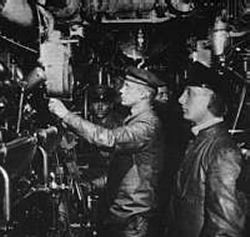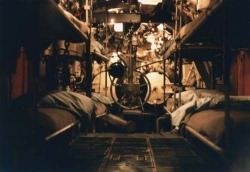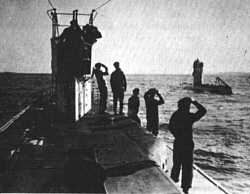| Silent Hunter II/Destroyer Commander Interview by Leonard "Viking1" Hjalmarson |
||||
|
For quite some time PC submarining action was dominated by SILENT SERVICE II and RED STORM RISING. Then Dynamix released their excellent ACES OF THE DEEP, where players took to the frigid waters of the North Atlantic as German U-boat captains. Finally, Silent Hunter arrived on patrol. SILENT HUNTER was first described as ACES OF THE DEEP, only in the Pacific with the US Sub Service, and in high resolution. While that is more or less true, SILENT HUNTER is also a class in itself. In SILENT HUNTER the player commands an American diesel submarine in WWII. Starting with the infamous attack on Pearl Harbor, hunting season for Japanese warships and merchants opens in the South Pacific. The general idea of the simulation is to sink as much tonnage as possible without ending up on the Still on Patrol list at the end of the war. The historical faithfulness of AOD is renowned, and SILENT HUNTER hit the same mark for accuracy, employing the services of William "Bud" Gruner, who was the technical advisor for the game. The Simulations Group at SSI/Mindscape is now at work on several projects for the new "DCS" (Digital Combat Series) line of products, including Harpoon IV and Destroyer Commander. Bill Becker, president of Aeon Electronic Entertainment and SSI Simulations Producer, Rick Martinez, form the nucleus of the Silent Hunter II collaboration. Executive Producer Carl Norman, (producer of the original Silent Hunter), is now heading up the SSI/Mindscape Simulations Group. Recently we had an opportunity to speak with Rick and Bill about where this new simulation will take us. CSIM: Lets start with some history. Silent Hunter was a fantastic entry into the genre, keeping my attention in a way that AOD never did. Tell us a bit about the conception of Silent Hunter and what you were attempting to accomplish. A: The subject of the American submarine force in the pacific had been neglected for quite some time. In fact, Silent Service II (1990) was the last significant game on the subject. We had talked for quite some time with SSI about doing the next generation of WWII sub sim and in early '94 the timing seemed right. From the start our goal was to create the most realistic sub simulation to date using the latest technology and the best graphics in the business.
 CSIM: SILENT HUNTER II simulates the German untersea service. How did this decision to simulate the other side of the war experience come about? A: The battle in the Atlantic was very different from the American experience in the Pacific. There were many interesting elements that we wanted to explore: the "technology war" between the Germans and the Allies, the large convoys and sophisticated tactics used by the allied escorts, the German Type XXI electric boats, wolf-packing, and the list goes on. The subject matter is intriguing and that's why people keep coming back to it over and over again. Silent Hunter II will simulate this intriguing subject matter in depth, focusing on the Battle of the Atlantic between 1939 and 1945. CSIM: Tell us about the process of developing SH2 from the perspective of research? What has been involved? A: Lots of reading, quite a bit of travel, and more travel yet to come! CSIM: This has obviously required a great deal of research. What museums or facilities have you visited and who have you spoken with? A: Here is a partial listing:
CSIM: What has been the most helpful from the technology standpoint? A: Most information culled from the museums has been in regards to technical issues. CSIM: What has been most helpful from the tactical standpoint? A: Books, books, and more books. We're still researching this area and are in the process of looking for several consultants. CSIM: Were there some surprises along the way? What were they? A: The biggest difficulty is in culling through all of the information available and selecting which source to believe when given contradictory information. There are many passions stirred when talking about the Battle of the Atlantic and many different opinions on the subject. Researching U-boats sometimes can seem like wading through a minefield. An example is the reaction to Clay Blair's Hitler's U-boat War series. |
 U 505. CSIM: The technological background of the U boat war in the Pacific really is fascinating. At a time when the war looked to be lost for the Allies, the German communications code was cracked and the Huff-Duff (HFDF) arrived on the scene. Tell us about these systems in Silent Hunter II, and when do they come into play?
 Enigma. A: Silent Hunter II realistically simulates the advancement of technologies and the tactics that were used in conjunction with their introduction. In 1942, the Allies developed the ship-based Huff Duff. While relatively short ranged, it gave an accurate bearing on a U-boat transmitting within twenty miles of the ship fitted with the equipment. Huff-Duff told the escorts the direction of an attack and the number of broadcasts indicated the number of U-boats to expect. Thus the U-boats lost the element of surprise. The story of Enigma, how the British broke the German code, and its effect on the outcome of the battle is well known. Silent Hunter II historically tracks the times that the British were able to read German naval communications and the times the Admiralty was effectively "blacked-out". In January 1942, the German radio code was changed and it took the British cryptanalysts until the autumn of 1942 to regain insight into U-boat operations. These elements are all modeled within the tactical and campaign game in detail. CSIM: Advances in Allied technology during the war will have to also be modeled. When does radar become a factor for the Allies, and how many types of radar are modeled from 1943-1945? A: We're trying to model as many of the radar types as possible in terms of general capability in both aircraft and surface ships. Early 150cm radar like the British ASV Mk1 and Mk2 starting on Coastal Command Hudsons and Sunderlands will be modeled. Later centimetric radar like the ASV Mk3 and DMS-1000 will be found on aircraft by Autumn of 1941 and most ships by May 1942. By mid-1944 3cm radars like the ASV Mk VII will appear. German radar detectors (Metox, Naxos) will also be available to the U-boat at the appropriate times.
Historical Note: Centimetric radar was made possible by the development, by J.T. Randall and H.A.H. Boot, of the cavity magnetron. The first was tested on 21 February 1940. By June 1940, GEC had produced the first sealed magnetrons, suitable for use in aircraft. Development concentrated on AI for nightfighthers, but in the autumn of 1940 the 10cm radar attracted naval interest when it was demonstrated that the ground-based equipment could track ships. By March 1941, a fully engineered 10cm radar was on board of the corvette HMS Orchis, and on 16 November 1941 the sinking of U-433 near Gibraltar was attributed to the "Type 271" 10cm radar. By May 1942, 236 ships carried centimetric radar.
 Vickers Wellington Medium Bomber. The first aircraft installation was made in a twin-engined Wellington bomber. On 17 March they saw their first U-boat at 9 miles, but the Leigh light failed and the first attack was made on the next day. At the end of March 13 sightings had been made. By May, Coastal Command detected and attacked most U-boats in the Bay of Biscay. U-boat sightings improved dramatically, and shipping losses decreased drastically, from 400,000 to 100,000 tons per month. Doenitz ordered his submarines to stay on the surface and fight it out with aircraft, but he lost 56 U-boats in April and May. At this Doenitz reported that the situation had become "impossible". This "temporary setback" was significant enough to be mentioned in a speech by Hitler. This result had actually been achieved by a handful of aircraft equipped with ASV Mk.III. From the research of Emmanual Gustin. Go to Part II
|
|||
|
© 1997 - 2000 COMBATSIM.COM, INC. All Rights Reserved. Last Updated February 10th, 1999 |
||||

